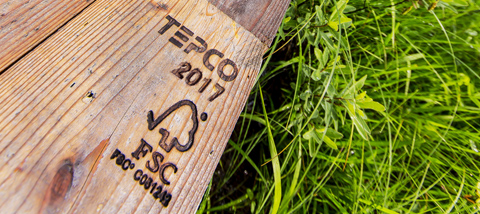Coexistence with Nature / Biodiversity
Biodiversity
Initiatives to Conserve Biodiversity
<GRI304-1,304-2,304-3,304-4>
The TEPCO Group recognizes that the various blessings born from the natural environment and biodiversity (Ecosystem services) are indispensable for our business. As a member of the Federation of Electric Power Companies of Japan (FEPC), we are engaging in biodiversity conservation and sustainable use initiatives, such as reducing the burden on the environment, conserving rare species on company-owned land, etc., and promoting awareness about biodiversity conservation in accordance with the FEPC’s the Electric Utility Industry’s Action Guidelines for Biodiversity (created in April 2010, revised in June 2020), which serves as principles of conduct for sustainable business, in order to contribute to the creation of a symbiotic society.
The Impact of Business on Biodiversity
<GRI304-2>
Preventing Deforestation
If forestry development is necessary as a result of facility construction, the TEPCO Group complies with regulations, etc. stipulated in forestry laws and ordinances for the region and implements conservation measures that prevent the loss of the multifunctional roles of forests in order to directly prevent deforestation. We also continue to conserve and maintain regional watershed protection forests like the Oze National Park. As an indirect measure to prevent deforestation, the TEPCO Group engages in Green procurement through which we strive to use products that consider forest management and the sustainability of paper and wood resources.
Mitigating the Impact of Development
Land modifications made when constructing power facilities, such as power stations and transmission/distribution equipment, etc., have the potential to impact biodiversity. In order to minimize the damaging impact on biodiversity through development activities, the TEPCO Group complies with environmental laws in our areas of business and engages in measures to suitably conserve the natural environment. These measures are implemented based on the mitigation hierarchy approach to conservation according to which we strive to avoid, reduce, and compensate, in that order, through agreements with third parties and environmental assessments that have scientific basis.
Mitigating the Impact from the Presence of Facilities
Environmentally hazardous substances emitted from facilities have the potential to impact biodiversity. In addition to complying with emission standards and regulations for environmentally hazardous substances, the TEPCO Group also engages in initiatives to reduce the burden on the environment over the long-term, such as initiatives to turn renewable energies into the main power sources, by reducing greenhouse gas (GHG) emissions. We also suitably manage the green area around our facilities and strive to maintain the environment and landscape.
Conservation of the Oze National Park
<GRI304-1,304-3>
Oze consists of the Ozegahara (marshlands) and Ozenuma (bog) that extend across the four prefectures of Gunma, Fukushima, Niigata and Tochigi. Centered around a high moor and home to over 900 species of plants, 100 species of birds, and 40 species of dragonfly, Oze is Japan’s largest wetlands. And, the plentiful wildlife and diverse geography make this area a valuable ecosystem for academics as well. Oze was registered under the Ramsar Convention (Criteria: 1, high moor/freshwater lake, Wetland type: U, O, Registered area: 8,711ha) in 2005.
TEPCO owns 16,334ha of land in Oze. Approximately 40% of this land makes up the Oze National Park, and approximately 70% of that (6,277ha) is designated as a special conservation area (wetlands registered under the Ramsar Convention). Originally the land was to be used for the construction of power generation facilities, but after withdrawal of the hydropower plant (dam) construction plan, the land has been maintained as
a watershed protection forest and TEPCO has worked with regional partners for more than 60 years to help conserve the region and enable the ecosystem to recover. TEPCO has worked as a member of the Oze Preservation Foundation since its establishment in 1995 to promote environmental measures and preservation in Oze along with regional partners, and ensure that the region is used in a suitable manner by visitors.
Noteworthy Species in Oze <GRI304-4>
| source: Information Sheet on Ramsar Wetlands (RIS) and Lank | Latest rank |
|---|---|
| Noteworthy flora: | |
| Nuphar pumilum [VU]*1 | [VU]*2 |
| Chara globularis [CR+EN]*1 | [CR+EN] *2 |
| Amitostigma kinoshitae [VU]*1 | [VU]*2 |
| Iris laevigata [VU]*1 | [NT]*2 |
| Cirsium homolepis [VU]*1 | [VU]*2 |
| Pogonia japonica [VU]*1 | [NT]*2 |
| Habenaria sagittifera [VU]*1 | [VU]*2 |
| Drosera anglica [VU]*1 | [VU]*2 |
| Viola kamtschadalorum [VU]*1 | [NT]*2 |
| Carex nemurensis [VU]*1 | [NT]*2 |
| Utricularia uliginosa [VU]*1 | [NT]*2 |
| Noteworthy fauna: | |
| [Birds] | |
| Aquila chrysaetos japonica (Golden eagle) [EN]*1 | [EN]*2 |
| Spizaetus nipalensis orientalis (Hodgson's hawk-eagle) [EN]*1 | [EN]*2 |
| Accipiter gentilis (Goshawk) [VU]*1 | [NT]*2 |
| Falco pergrinus japonensis (Peregrine falcon) [VU]*1 | [VU]*2 |
| Pericrocotus divaricatus (Ashy minivet) [VU]*1 | [VU]*2 |
| Lanius tigrinus Drapiez (Thick-billed shrike) [VU]*1 | [CR]*2 |
| Emberiza yessoensis (Japanese reed bunting) [VU]*1 | [VU]*2 |
| Gorsachius goisagi (Japanese night heron) [NT]*1 | [VU]*2 |
| Pandion haliaetus (Osprey) [NT]*1 | [NT]*2 |
| Pernis apivorus (Honey Buzzard) [NT]*1 | [NT]*2 |
| Accipiter nisus (Sparrow hawk) [NT]*1 | [NT]*2 |
| Lanius cristatus (Brown shrike) [NT]*1 | [EN]*2 |
| [Insects] | |
| Nehalennia speciosa [NT]*1 | (No longer specified)*2 |
-
Note: *1
List of Endangered and Threatened Species in Japan. Ministry of the Environment (As of 8 Nov. 2005)
-
Note: *2
List of Endangered and Threatened Species in Japan. Ministry of the Environment (As of 12 Aug. 2021)
CR: Critically Endangered
EN: Endangered
VU: Vulnerable
NT: Near Threatened
Environmental Communication
Environmental Education Support Activities in Oze
For TEPCO, Oze is also a place of further communication with our stakeholders. We provide environmental education support with activities a particular focus on future generations, elementary and junior high school students, to provide experiences in the precious nature of Oze and learn about the importance of nature conservation and biodiversity.
<Reference>
| Off-site education | On-site explanations | Participation to Eco Event, etc. | Total | |
|---|---|---|---|---|
| 2018 | 16 | 31 | 8 | 55 |
| 2019 | 14 | 40 | 20 | 74 |
Related Information
We promote various initiatives in collaboration with local communities and NGOs/NPOs, including participating in the Fuji Forest Restoration Project (OISCA).
















